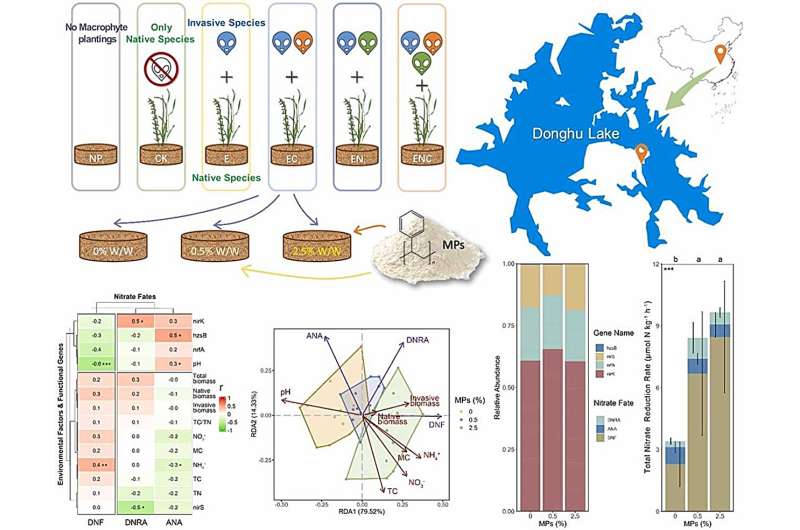This article has been reviewed according to Science X's editorial process and policies. Editors have highlighted the following attributes while ensuring the content's credibility:
fact-checked
peer-reviewed publication
trusted source
proofread
Study reveals how invasive submerged macrophytes affect sediment nitrogen cycle under complex environments

Removal of excess nitrogen is a critical step in the ecological restoration of eutrophic lakes. Microbially mediated dissimilatory nitrate reduction processes in lakes represent an important mechanism for nitrogen removal. However, lake ecosystems are facing an increasingly complex and severe threat from invasive submerged macrophytes and microplastic pollution.
The differences between invasive and native submersed macrophytes in terms of root organic matter secretion and nitrogen assimilation efficiency can alter the dissimilatory nitrate reduction processes in sediments. It is evident that microplastics can directly alter the physicochemical properties of sediments and indirectly affect the rate of dissimilatory nitrate reduction processes and the interrelationships of the system by influencing the health of submerged macrophytes. However, it is not clear whether the diversity of invasive submerged macrophytes affects dissimilatory nitrate reduction processes in sediments in the context of microplastic contamination.
Supervised by Prof. Xing Wei, Gao Xueyuan, A Ph.D. student from the Wuhan Botanical Garden of the Chinese Academy of Sciences, has conducted a cross-experiment on the addition of polystyrene microplastics (PS-MPs) and the diversity of invasive submerged macrophytes to analyze their effects on the physicochemical properties of the sediment, the structure of the microbial community, and the potential rates of the various dissimilatory nitrate reduction processes. The findings are published in the Journal of Hazardous Materials.
The results showed that denitrification processes were more sensitive to the diversity of invasive submerged macrophytes than dissimilatory nitrate reduction to ammonium (DNRA) and Anammox. However, the addition of PS-MPs appeared to interfere with the effect of invasive submerged macrophyte diversity on the dissimilatory nitrate reduction processes.
The addition of PS-MPs significantly altered the physicochemical environment of the sediment, including a remarkable decrease in sediment pH, increased nitrate and ammonia concentrations, and other notable changes. Furthermore, the addition of PS-MPs induced changes in the sediment microbial community.
As the concentration of PS-MPs increased, the number of unique genera in the microbial community increased. Endemic genera of the microbial community increased, alpha diversity increased, and resulted in a more stable microbial community structure. The physicochemical changes in the sediment environment induced by PS-MPs created a more conducive setting for denitrification to occur, thereby further enhancing the competitive advantage of this process over DNRA. In addition, the addition of PS-MPs inhibited the anammox.
Overall, the response of dissimilatory nitrate reduction processes to invasive submerged macrophyte diversity showed process specificity. However, the incorporation of PS-MPs resulted in a non-synergistic effect that weakened the expression of the model influence of invasive submerged macrophyte diversity on dissimilatory nitrate reduction processes.
The results of this study expand the understanding of invasive submerged macrophytes in lake ecosystems and the impact of microplastic accumulation on functional microbial communities and sediment nitrogen cycling systems.
More information: Xueyuan Gao et al, Does invasive submerged macrophyte diversity affect dissimilatory nitrate reduction processes in sediments with varying microplastics?, Journal of Hazardous Materials (2024). DOI: 10.1016/j.jhazmat.2024.134510
Journal information: Journal of Hazardous Materials
Provided by Chinese Academy of Sciences





















